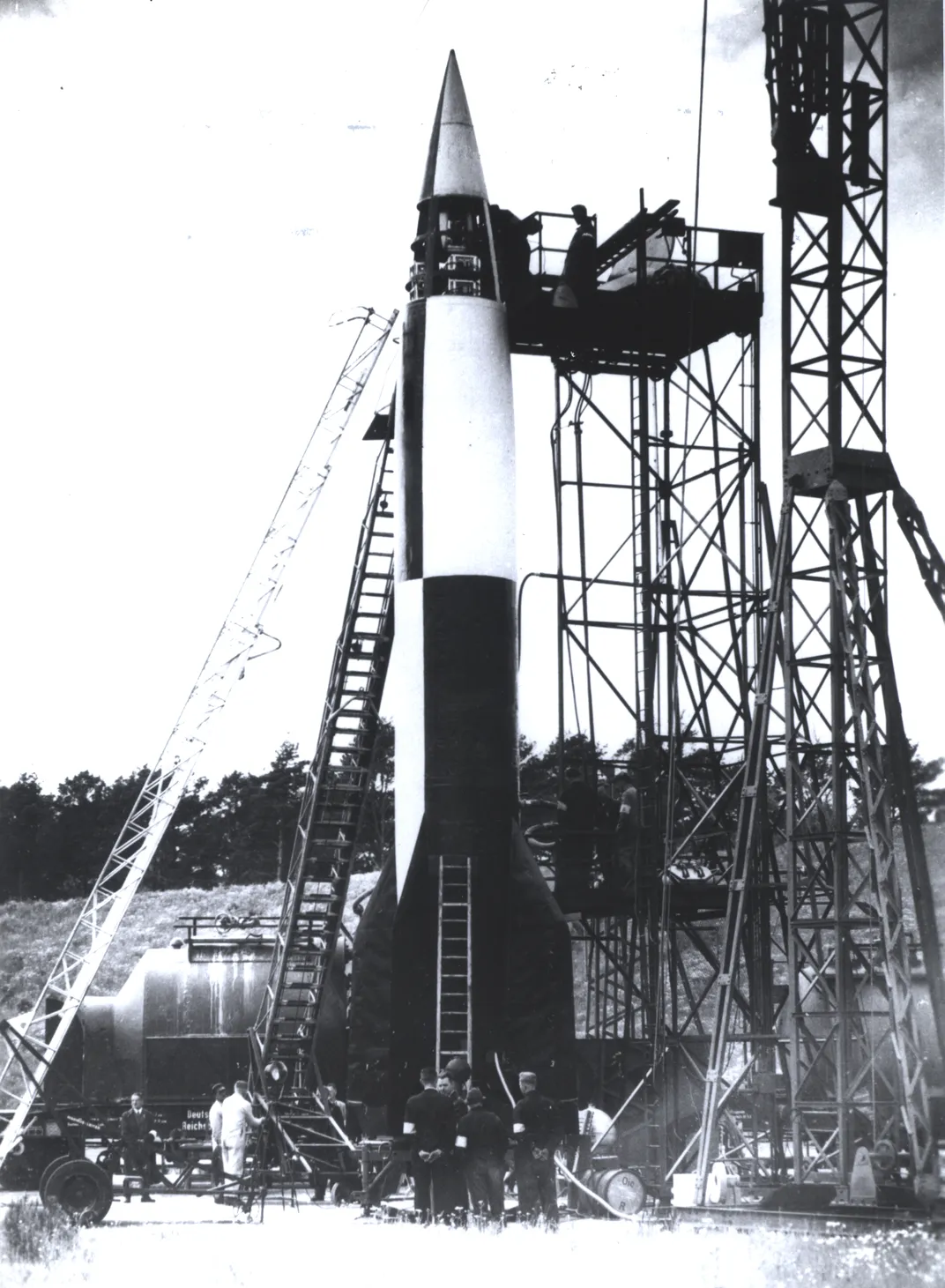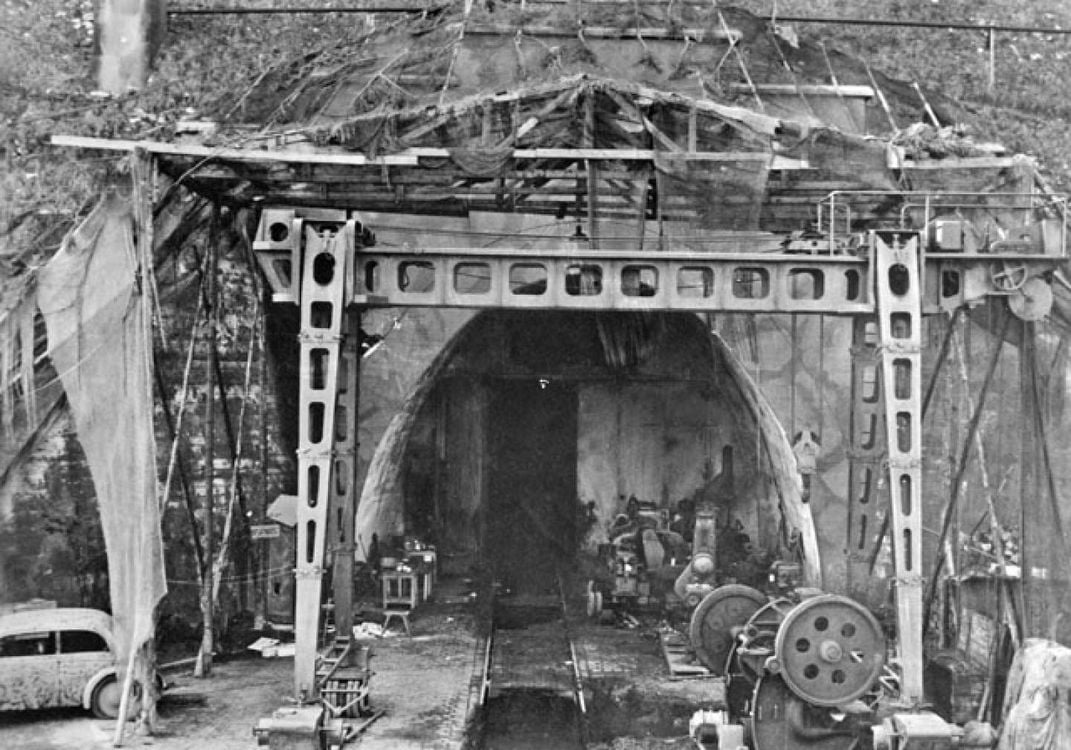“Wonder Weapons” and Slave Labor
Curator Michael Neufeld discusses how Nazi Germany’s high-tech weapons were assembled in part by forced and slave labor from the various Nazi camp systems.
:focal(720x504:721x505)/https://tf-cmsv2-smithsonianmag-media.s3.amazonaws.com/blogging/featured/SI-79-13171_A_1.jpg)
Recently I wrote about the overblown reputations of the “wonder weapons” that Nazi Germany deployed in the last year of World War II—notably, the V-1 cruise missile, the V-2 ballistic missile, the Me 163 rocket fighter, and the Me 262 jet fighter. Far from coming “too late” to change the course of the war, they were all too premature and flawed to have any decisive impact on it. In the second blog in this series, I want to focus on how all of these high-tech weapons were assembled in part by forced and slave labor from the various Nazi camp systems. Some of the advanced technologies of 1944-45 were built by imprisoned workers at gunpoint—and it cost the lives of thousands of them. In fact, in the case of the V-2, more than twice as many Allied prisoners died outfitting the factory and producing it than did Allied civilians and soldiers hit by it in rocket attacks.

V-2 assembly at the underground Mittelwerk (“Central Works”) in north-central Germany is by far the best-known case of forced labor to build Nazi Germany’s weapons. Thanks to pioneering scholarship since the 1970s, we know a lot about this factory, which also began producing V-1 “buzz bombs” in fall 1944. Following the British Royal Air Force’s massive raid on the Peenemünde rocket development facility on the Baltic in August 1943, Hitler ordered that V-2 production move underground. Within days, the decision was made to repurpose an old mine outside Nordhausen that was being used as a strategic storage dump for oil products and chemical weapons. By the end of August, a “work commando” of prisoners from the Buchenwald SS concentration camp was sent to the tunnels. They became the core of the new Dora sub-camp. Their first task was to remove the storage tanks and other equipment and start blasting to extend one of the two parallel main tunnels all the way through Kohnstein mountain (the other was already finished). In the fall and winter of 1943/44, that quickly became a hell on Earth.

Since missile production was an urgent national priority and prisoner health and safety were irrelevant, no importance was placed on building an above-ground barracks camp. The prisoners were housed in improvised “sleeping tunnels” with rows of bunk beds. Barrels cut in half with a board on top of them were used as toilets. Blasting went on day and night, filling the living area with dust. Starvation and bad hygiene exacerbated outbreaks of diarrhea and typhoid fever. Guards shot or beat to death prisoners who couldn’t keep up. By the end of the winter, 3,000 prisoners had died, and another 3,000 ill or dying were shipped off to certain death in other concentration camps. Detainees accused of sabotage, rightly or wrongly, were hung on the roll-call square of the barracks camp outside the south entrances to the tunnels, which is where the survivors moved in spring 1944.
The prisoners who did most of the semi-skilled work were almost all French and Belgian Resistance fighters, like those shown in this striking color picture taken by the Nazi propaganda photographer Walter Frentz. In the Nazi racial hierarchy, Western Europeans were valued more and got better, more skilled jobs than the Polish and Soviet prisoners who made up half the camp population and got stuck with the dirtiest and most dangerous work. None of the prisoners were Jewish, at least not until fall 1944, when a group of Hungarian Jews were sent to Dora to work on the V-1. That assembly line was installed in the former “sleeping tunnels.”
The spring, summer, and fall of 1944 were the best period for prisoners in the Dora camp, which became the new SS main camp Mittelbau (Central Construction). The death rate fell drastically because of the aboveground barracks, the end of the tunneling, and the need to treat detainees a little better in the interest of quality production (beatings, hangings, and slow starvation did not stop, however). But just as the main camp stabilized, the SS created a number of sub-camps in the region to tunnel out new underground factories. SS General Hans Kammler, who had supervised construction of the Auschwitz gas chambers, had his authority expanded from Mittelwerk factory construction to similar facilities for a new Fighter Program. Armaments Minister Albert Speer and Air Minister Erhard Milch wanted to ramp up fighter production as an emergency response to the Allied strategic bomber offensive ravaging German cities and factories. Kammler took on the task of tunneling out underground plants all over Greater Germany (which included Austria and other annexed areas). He did so with the contempt for prisoner lives he evidenced in the Mittelwerk. Thus, even as the situation improved for detainees in the Mittelbau-Dora main camp, horrifying conditions prevailed at many of the new subcamps devoted to tunneling near Nordhausen, leading to several thousand new deaths. None of these new facilities were completed by the end of the war, meaning all they produced were dead bodies, rather than jet fighters. The same applied to virtually all of the underground plants in Germany and Austria.
The Fighter Program also forced the Mittelwerk to consolidate missile assembly in the southern half of the tunnels, so that an aero-engine factory dubbed the Nordwerk (North Works) could be set up in the other half. That Junkers engine factory produced, in part, Jumo 004 powerplants for the Messerschmitt Me 262 and Arado Ar 234 jet aircraft. The laborers for that plant were not drawn from Dora. Instead, new barracks were set up in the valley to the north for foreign laborers. This was the normal labor supply for the Nazi war economy in the mid- and late war. There were seven million foreign workers in the Reich in 1944, supplementing a German workforce consisting mostly of women and those men who were too old to serve in the military or whose skills were valued too highly. The foreign workers were almost all forced laborers— badly paid and effectively imprisoned. The so-called Ostarbeiter (“East Workers”), mostly girls and women recruited or rounded up in Poland and the occupied Soviet Union, were in particular not treated much better than the 700,000 people held in SS concentration camps in mid-1944. The net result was that the entire war economy of Nazi Germany was founded on forced and slave labor, which means that every weapon produced after 1942 has such work incorporated in it—including every aircraft and “wonder weapon.”
In the winter of 1944/45, conditions for the prisoners went from bad to worse as regular food supply began to fall apart and the SS stepped up repression. As Allied armies approached from east and west, concentration camp prisoners were evacuated into the Reich in open rail cars and death marches. At Mittelbau-Dora, trains showed up from Auschwitz and Gross Rosen camps full of frozen bodies and emaciated, deathly ill survivors, most of them Jewish. Those too ill to work were dumped into barracks and hangars in the city of Nordhausen, 1,500 of whom were killed when the Royal Air Force burned down most of the town in an early April 1945 air raid.

It is estimated that 20,000 to 25,000 detainees died in the Mittelbau camp system, out of 60,000 sent there. A quarter century ago, I calculated in The Rocket and the Reich that a minimum of 10,000 deaths might be attributed the V-2 program at the Mittelwerk (the rest would largely be the responsibility of the Fighter Program). Since the missile caused a bit over 5,000 Allied deaths, primarily in London and Antwerp, that made the rocket a unique weapon: twice as many died producing it (or building the factory to produce it) than being hit by it. And the ten thousand figure is only for Mittelbau-Dora—concentration camp prisoners were used in many parts of the V-2 rocket program, including Peenemünde itself. An accounting of manufacturing-related deaths outside Dora has never been attempted, but it could be up to another 10,000.
Thus, as you gaze on the V-1 and V-2 at the Museum in DC, or on the Museum’s collection of late-war German aircraft and missiles at the Udvar-Hazy Center, think of the forced and slave laborers who toiled to produce them. The Nazis inflicted so much suffering and death just to produce these flawed and often ineffective icons of high technology.
Michael J. Neufeld is a senior curator in the Museum’s Space History Department and is responsible for German World War II rockets and missiles, among other collections. He is also the author of Von Braun: Dreamer of Space, Engineer of War (2007).
